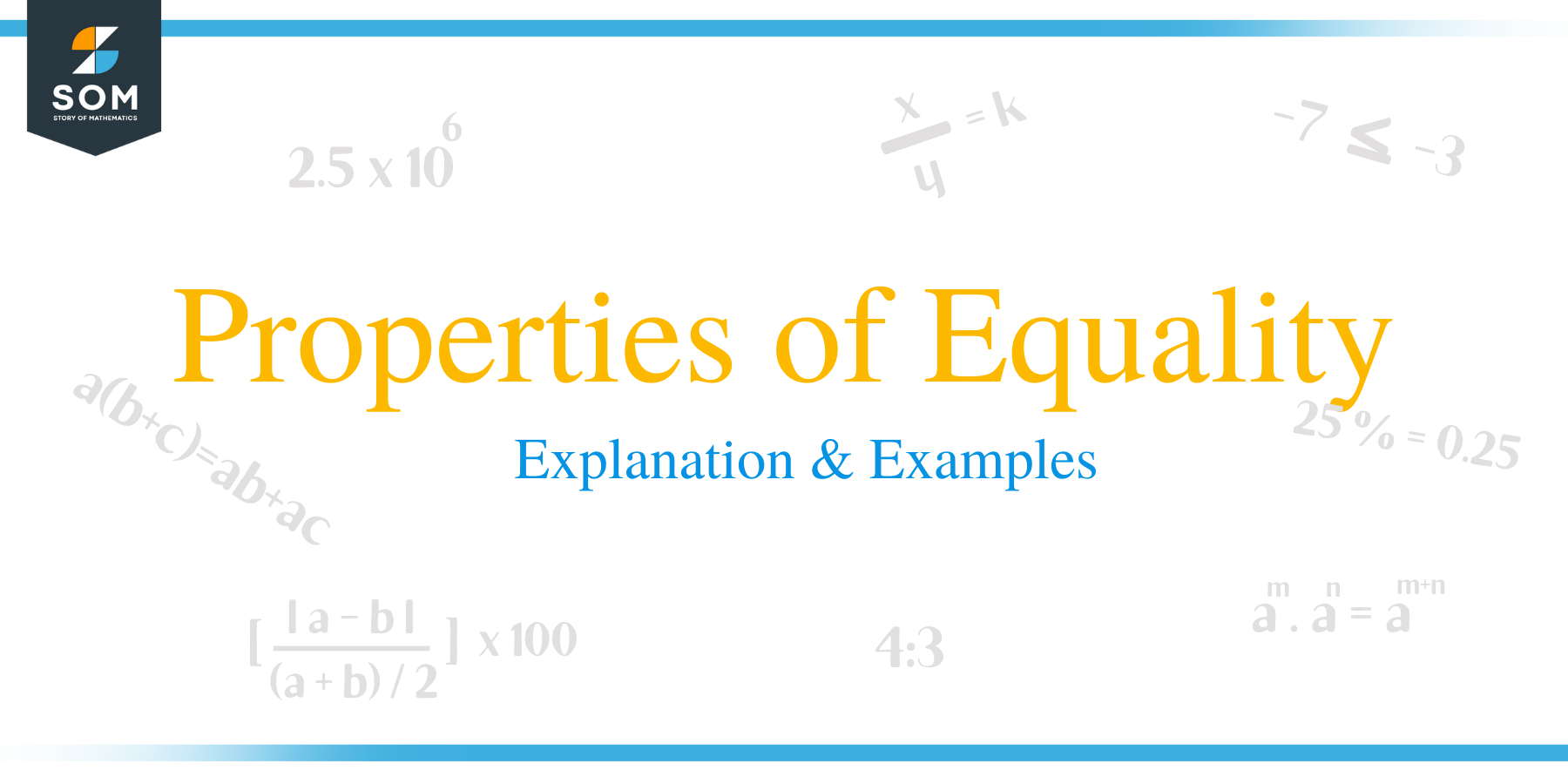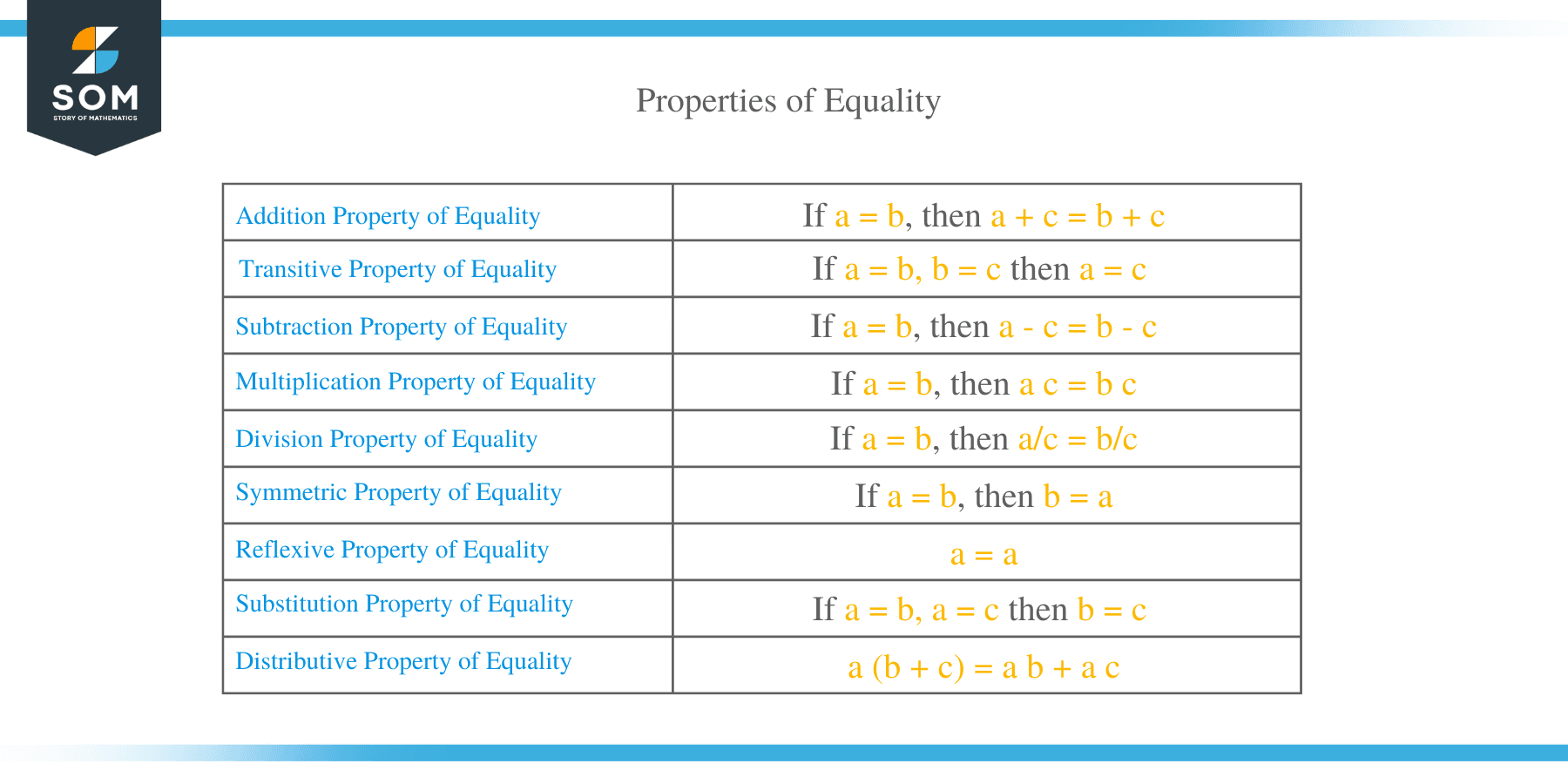- Home
- >
- Properties of Equality – Explanation & Examples
Properties of Equality – Explanation and Examples
 Properties of equality are truths that apply to all quantities related by an equal sign.
Properties of equality are truths that apply to all quantities related by an equal sign.
That is, the properties of equality are facts about equal numbers or terms. These nine properties are fundamental for all proofs in all branches of mathematics and logic.
Before moving on with this section, make sure to review basic properties of arithmetic. This article simply gives an overview of each property of equality. It also links to articles that give a fuller picture of each of the properties.
This section covers:
- What Are Properties of Equality?
- How Are Properties of Equality Used?
- Examples of Properties of Equality
What Are Properties of Equality?
Properties of equality are facts about any two or more quantities related with an equal sign.
Many of these facts may seem so obvious that they don’t need to be said. On the contrary, however, they are actually foundational for all branches of mathematics. If they were not explicitly defined, there would not be sufficient rigor to make any branches of math make sense.
Most of these facts have been known for hundreds of years and have been used in many proofs.
For example, Euclid defined the transitive, additive, subtractive, and reflexive properties of equality in Elements as common notions. That is, he used these facts so much that he made them easier to reference.
Many of the properties of equality are also related to both numerical and non-numerical logic. This gives them uses in topics as diverse as law and computer science.
Addition Property of Equality
The addition property of equality says that adding a common value to two equal quantities retains the equality.
That is, if $a, b,$ and $c$ are real numbers and $a=b$, then:
$a+c=b+c$.
Transitive Property of Equality
The transitive property of equality states that things which are equal to a common term are equal to each other.
Arithmetically, if $a, b,$ and $c$ are real numbers and $a=b$ and $b=c$, then:
$a=c$.
Subtraction Property of Equality
The subtraction property of equality says that equality holds when subtracting a common term from two equal terms.
That is, if $a, b, c$ are real numbers and $a=b$, then:
$a-c=b-c$.
Multiplication Property of Equality
The multiplication property of equality states that multiplying equal quantities by a common term does not change the equality.
Arithmetically, if $a, b,$ and $c$ are real numbers and $a=b$, then:
$ac=bc$.
Division Property of Equality
The division property of equality is just like the addition, subtraction, and multiplication properties. It says that dividing equal terms by a common value keeps the equality as long as long as the divisor is not zero.
That is, if $a$ and $b$ are real numbers, $c$ is a real number not equal to zero, and $a=b$, then:
$\frac{a}{c}=\frac{b}{c}$.
Symmetric Property of Equality
The symmetric property of equality states that it does not matter whether a term is on the left or right side of an equal sign.
Arithmetically, if $a$ and $b$ are real numbers and $a=b$, then:
$b=a$.
Reflexive Property of Equality
The reflexive property of equality says that all things are equal to themselves.
That is, for any real number $a$:
$a=a$.
Substitution Property of Equality
The substitution property of equality allows equal quantities to replace each other at any time in any math sentence.
There is not a concise arithmetic way of writing the substitution property of equality. There are endless illustrations though. For example, if $a, b$ and $c$ are real numbers, $a-4=c$, and $a=b$ then:
$b-4=c$.
Distributive Property of Equality
The distributive property of equality states that equality holds after distributing with multiplication.
While the distributive property is true for any number of terms, the most common arithmetic formulation of it uses two terms.
For example, if $a, b,$ and $c$ are real numbers, then:
$a(b+c)=ab+ac$.
How Are Properties of Equality Used?
Properties of equality are useful in a variety of mathematical contexts.
In arithmetic, properties of equality play a key role in identifying whether or not expressions are equivalent.
In algebra, properties of equality are useful for isolating and solving for an unknown variable.
The properties of equality are also foundational for the study of logic and computer programming. They ensure internal consistency and provide key steps for proofs.
Examples
This section covers common problems using properties of equality and their step-by-step solutions.
Example 1
Let $a=b$ and let $c$ be a real number. Identify the property of equality that justifies each of the equations.
A. $a=a$
B. $b=a$
C. $a+c=b+c$
Solution
The reflexive property of equality justifies statement A because it states that all things are equal to themselves. This means $a$ is equal to $a$.
The symmetric property of equality justifies statement B. The fact that $a=b$ is given. The symmetric property of equality will extend this to $b=a$.
Finally, the addition property of equality justifies statement C. This is because a common value is added to both $a$ and $b$, keeping the equality.
Example 2
Let $j=k$, $k=l$, and $l=m$.
Given these facts, use the transitive property of equality to find at least two equivalent statements.
Solution
The transitive property of equality states that if $a=b$ and $b=c$, then $a=c$.
To use the transitive property of equality, first find two equations with one side the same. In this case, $j=k$ and $k=l$.
Then, $j=l$ by the transitive property.
Likewise, since $k=l$ and $l=m$, $k=m$ by the transitive property.
Also, since $j=k$ and $k=m$, using the transitive property one more time, then $j=m$ too.
Example 3
Two printers each have 500 sheets of paper inside. Helen prints a 5-page file using the first printer, and Bob prints a 5-page file using the second printer.
Which property of equality states that the two printers will still have the same number of sheets of paper inside?
Solution
In this case, it is required to first convert the problem into math equations and expressions.
Let $h$ be the number of sheets in the first printer and $b$ be the number of sheets in the second printer.
$h=500$ and $b=500$. The transitive property of equality says that $h=b$.
Next, Helen uses 5 sheets of paper from the first printer. Therefore, it will have $h-5$ sheets of paper left in it.
Then, Bob uses 5 sheets of paper from the second printer. After that, it will have $b-5$ sheets left in it.
Since $h=b$ and $5=5$ by the reflexive property of equality, $h-5=b-5$ by the subtraction property of equality.
Therefore, this word problem gives examples of the subtraction property of equality, the reflexive property of equality, and the transitive property of equality.
Example 4
Let $a=b$, $b=c$, and $d=f$. The proof below shows that $a+b(c+d+f)=2a^2+4ad$. Justify each step in the proof.
- $a+b(c+d+f)=a+a(c+d+f)$
- $a+a(c+d+f)=2a(c+d+f)$
- $2a(c+d+f)=2a(c+d+d)$
- $2a(c+d+d)=2a(c+2d)$
- $2a(c+2d)=2ac+4ad$
- $2ac+4ad=2aa+4ad$
- $2a^2=4ad$
Solution
The first step is true because of the substitution property of equality. Since $a=b$, either can replace the other at any time. In this case, $a$ replaces $b$.
The second step is to simplify because $a+a=2a$.
The third step also uses the substitution property of equality. Since $d=f$, either can replace the other at any time. In this case, $d$ replaces $f$.
Similar to above, the fourth step is to simplify. This is because $d+d=2d$.
The fifth step employs the distributive property of equality. Multiply $2a$ by each term inside the parenthesis to get $2a\times c$ and $2a\times 2d$. These two terms simplify to $2ac+4ad$.
The sixth step relies on both the transitive property of equality and the substitution property of equality. Since $a=b$ and $b=c$, $a=c$ by the transitive property of equality.
The substitution property then states than $a$ can replace $c$ in any equation, as in step 6.
Finally, simplify. $aa=a^2$.
Example 5
Let $\frac{2}{7}x-3=9$. Use the properties of equality to find the value of $x$.
Solution
Begin with the fact that $\frac{2}{7}x-3=9$.
The subtraction property of equality says that the two sides will still be equal if 3 is added to both sides. That is:
$\frac{2}{7}x-3+3=9+3$.
This simplifies to:
$\frac{2}{7}x=12$.
Now, the multiplication property of equality says that the two sides will still be equal if each is multiplied by $\frac{7}{2}$. That is:
$\frac{7}{2}\times\frac{2}{7}x=\frac{7}{2}\times12$
This simplifies to:
$1\times x=42$ or $x=42$.
Thus, the value of $x$ is $42$.
